活性炭对水中六价铬的吸附研究
水溶液中六价铬在低成本活性炭上吸附的平衡和热力学研究(IJEM-V10-N2-5)
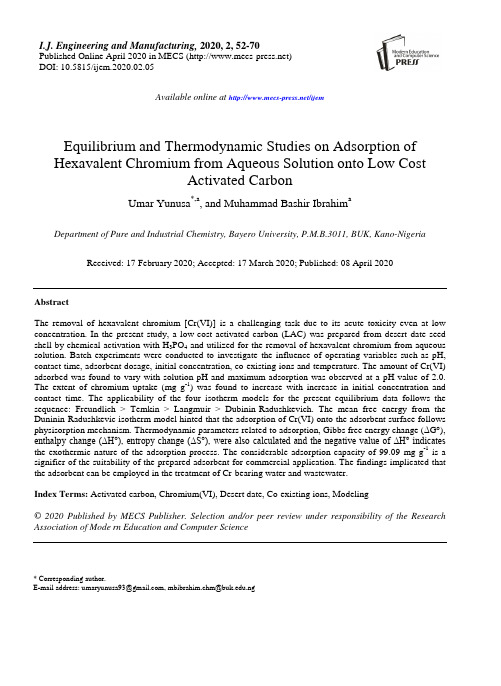
I.J. Engineering and Manufacturing, 2020, 2, 52-70Published Online April 2020 in MECS ()DOI: 10.5815/ijem.2020.02.05Available online at /ijemEquilibrium and Thermodynamic Studies on Adsorption ofHexavalent Chromium from Aqueous Solution onto Low CostActivated CarbonUmar Yunusa*,a, and Muhammad Bashir Ibrahim aDepartment of Pure and Industrial Chemistry, Bayero University, P.M.B.3011, BUK, Kano-Nigeria Received: 17 February 2020; Accepted: 17 March 2020; Published: 08 April 2020AbstractThe removal of hexavalent chromium [Cr(VI)] is a challenging task due to its acute toxicity even at low concentration. In the present study, a low-cost activated carbon (LAC) was prepared from desert date seed shell by chemical activation with H3PO4 and utilized for the removal of hexavalent chromium from aqueoussolution. Batch experiments were conducted to investigate the influence of operating variables such as pH, contact time, adsorbent dosage, initial concentration, co-existing ions and temperature. The amount of Cr(VI) adsorbed was found to vary with solution pH and maximum adsorption was observed at a pH value of 2.0. The extent of chromium uptake (mg g-1) was found to increase with increase in initial concentration and contact time. The applicability of the four isotherm models for the present equilibrium data follows the sequence: Freundlich > Temkin > Langmuir > Dubinin-Radushkevich. The mean free energy from theDuninin-Radushkevic isotherm model hinted that the adsorption of Cr(VI) onto the adsorbent surface follows physisorption mechanism. Thermodynamic parameters related to adsorption, Gibbs free energy change (∆G°), enthalpy change (∆H°), entropy change (∆S°), were also calculated and the negative value of ∆H° indicates the exothermic nature of the adsorption process. The considerable adsorption capacity of 99.09 mg g-1 is a signifier of the suitability of the prepared adsorbent for commercial application. The findings implicated thatthe adsorbent can be employed in the treatment of Cr-bearing water and wastewater.Index Terms: Activated carbon, Chromium(VI), Desert date, Co-existing ions, Modeling© 2020 Published by MECS Publisher. Selection and/or peer review under responsibility of the Research Association of Mode rn Education and Computer Science* Corresponding author.E-mail address: umaryunusa93@, mbibrahim.chm@.ngEquilibrium and Thermodynamic Studies on Adsorption of Hexavalent Chromium from 53Aqueous Solution onto Low Cost Activated Carbon1.IntroductionHeavy metal pollution of industrial effluent is a serious environmental problem due to their nonbiodegradabilty and acute toxicity. The problem becomes more worrying as our population soar and our industrialization becomes more vehement. Many chromium compounds are used in various industries such as electroplating, metal fabrication, dyeing and leather [1]. They also find applications in other industrial processes such as steel production, mining, petroleum refining, wood preservation, anodizing of aluminum, water-cooling, nuclear power plants, cement, ink, ceramic and glass [2]. Generally, industrial effluents contain both the trivalent Cr(III) and hexavalent Cr(VI) form of chromium. Among the two forms of chromium, the hexavalent specie is relatively more toxic and is deemed to be carcinogenic [3]. Therefore, it is mandatory to treat chromium-bearing effluents before disposal in to the recipient environment to avoid consequent health issues.Treatment technologies for remediation of chromium-bearing wastewaters include membrane filtration, ultrafiltration, ion exchange, co-precipitation, electrolytic methods, photocatalysis and adsorption [4]. However, most of these established techniques are not capable of efficiently reducing chromium concentration to tolerable limit [5]. They also suffer from economic and technological drawbacks, such as intensive operation, energy-expensiveness, high processing/operational cost, high chemical consumption and the generation of colossal amount of secondary pollutants [6]. Most conventional techniques are therefore not profitable as industrial-scale method for removal of chromium from aqueous medium [7].In an effort to enhance removal efficiency, considerable research efforts have been devoted to addressing the shortcomings associated with conventional treatment options, predominantly via adsorption. The use of adsorbents of natural origin has emerged in the recent years as one of the most viable options to established pollutant management strategies [8]. Many literatures have reported the use of various agricultural waste and byproducts such as maize cob [9], sawdust [10], hazelnut shell [11], groundnut hull [12], sugarcane bagasse [13], pea pod peel [14], avocado seed kernel [15], tea waste [16] and olive bagasse [17] as adsorbents for the removal of Cr(VI) from aqueous solution. However, most of the adsorbents have low adsorption capacity when utilized in their native form. To produce adsorbents with superior performance, the general trend lately has been that of modified adsorbents either by activation, grafting, changing the chemical form or through engineered composite materials [18].Activated carbons derived from agricultural wastes have been reported to exhibit valuable properties commensurable to those of available commercial active carbon. Actually, wastes from different agro-sources can serve as suitable precursors for making low-cost activated carbons with good adsorption efficiency. Moreover, proper utilization of these wastes can help reduce the burden on the environment in terms of disposal problem. However, no published references were available on the uptake of Cr(VI) specifically by desert date seed shell activated carbon. Presently, the seed shell is nothing but a waste having no practical utility. Since it is lignocellulosic in nature, it would be highly desirable to utilize such unused agro-waste as an alternative raw material for making activated carbon for chromium removal from water and wastewater. In view of the above, the present work was initiated to make an active carbon from abundant and locally available lignocellulosic waste (desert date seed shell) with objective to employ it as adsorbent for the reclamation of chromium-bearing effluent. The prepared carbon was characterized using electron microscopic technique and pH point of zero charge (pHpzc). The influence of operating variables such as initial concentration, contact time, adsorbent dose, pH, co-existing ions and temperature were investigated. Equilibrium isotherm models were tested and thermodynamic quantities (∆G, ∆H and ∆S) were evaluated and discussed. Moreover, the adsorptive properties of the newly prepared activated carbon was compared with previously reported adsorbents of similar category.54Equilibrium and Thermodynamic Studies on Adsorption of Hexavalent Chromium fromAqueous Solution onto Low Cost Activated Carbon2. Literature ReviewRecently, the removal of hexavalent chromium from aqueous solution using an activated carbon derived from Leucaena leucephala seed pod was investigated. The prepared activated carbon was characterized by proximate analysis, BET surface area measurement, SEM-EDX and FTIR. The obtained results showed that 100 min contact time, 1.0 g adsorbent dose, 45°C temperature and solution pH of 6.0 resulted in maximum Cr(VI) uptake. The experimental data better fitted to the Langmuir isotherm with monolayer adsorption capacity of 26.94 mg g-1. The kinetic analysis revealed that pseudo-second-order model fitted well to the acquired experimental data. Thermodynamic parameters showed the process to be spontaneous and endothermic in nature [19].In another study, modified biochar obtained after hydrothermal carbonization of Lepironia articulate was used for the removal of hexavalent chromium from aqueous medium. The performance of modified biochar was investigated through batch sorption experiments. Results revealed that removal (%) and the maximum adsorption capacity (qmax) of Cr(VI) onto the adsorbent increased up to 98.9% and 28.75 mg g-1 relative to 63.44% and 21.90 mg g-1 in unmodified biochar at pH 2.0, 313 K, and 200 mg dm-3 respectively. The sorption kinetics uptake data were best interpreted with pseudo-second-order model, and sorption isotherm was simulated with the Langmuir model. The thermodynamic parameters confirm the adsorption process to be endothermic and spontaneous [20].Cucumis melo peel activated carbon was utilized for the removal of hexavalent chromium from aqueous solution. Results obtained showed that the maximum removal of Cr (VI) was found to be 98 % at pH 3.0 with 250 mg of adsorbent when the concentration of the metal solution was 100 mg dm-3. The kinetics was based on pseudo-second-order equation and the equilibrium data was better fitted to Langmuir and Freundlich models [21]. Also, sugarcane bagasse was utilized as a low cost adsorbent for the removal of Cr (VI) in aqueous solution. Result revealed 100 % removal at pH 1.5 where on increasing the pH to 3.0 the removal efficiency was reduced to 17% [22].3. Materials and Methods3.1 ChemicalsPotassium dichromate (K2Cr2O7), phosphoric acid (H3PO4), sodium nitrate (NaNO3), sodium carbonate (Na2CO3), sodium chloride (NaCl), sodium hydroxide (NaOH) and hydrochloric acid (HCl) used were of analytical grade obtained from Sigma Aldrich. Deionized water was used in the preparation of all standard solutions. The Cr(VI) stock solution was prepared by dissolving 2.829 g of potassium dichromate in 1 dm3 deionized water. The needed experimental concentrations were prepared by appropriate dilution of the stock with deionized water. 0.1 mol dm-3 HCl and 0.1 mol dm-3 NaOH were used to adjust the initial solution pH depending on the requirement.3.2 EquipmentMicrowave Plasma-Atomic Emission Spectrometer (4210 MP-AES; Agilent) was used for the determination of residual Cr(VI) concentration. Incubator shaker (Innova 4000; New Brunswick Scientific) was employed for the agitation of the sample solutions during batch experiments. pH meter (3510; Jenway) was used for pH measurement. Centrifuge (Centurion 4000 Series) was employed for centrifugation after each adsorption experiment. The thermal treatment during activated carbon preparation was carried out in a muffle furnace (SXL-1008). Surface morphology of the adsorbent was examined using scanning electron microscopeEquilibrium and Thermodynamic Studies on Adsorption of Hexavalent Chromium from 55Aqueous Solution onto Low Cost Activated Carbon(PRO: X: Phenonm World 800-07334).3.3 Preparation of Activated CarbonThe preparation of the activated carbon was largely guided by the method described by [23], however with modification in the activating agent used (H3PO4 instead of KOH). The desert date seed shells were first washed thoroughly with water to get rid of surface adhered impurities. They were subsequently air dried for 48 h and then in an oven at 105o C overnight. The dried shells were ground and screened to pass through a 1 mm sieve to remove larger particles. They were subsequently carbonized at 700o C in a muffle furnace for 90 min. The carbonized sample was then mixed with solution of the activating agent such that the mass ratio of H3PO4 to charcoal was 3:1. This was followed by second heating at 750o C for 90 min. The sample was cooled, washed first with 0.1 mol dm-3 HCl and then thoroughly with deionized water until a neutral pH was attained. The desired activated carbon was obtained after drying in an oven at 110°C for 24 h.3.4 Characterization of Adsorbent3.4.1 Scanning electron microscopy (SEM)/Energy dispersive spectroscopy (EDS)The morphological features and elemental composition of the adsorbent were analyzed using SEM/EDS analysis. The samples were placed on brass stubs using adhesive tape on both sides. Scanning were done at an accelerating voltage of 15.00 kV and at x1000 magnifications.3.4.2 pH point of zero charge measurements (pHpzc)The pH point of zero charge of the LAC was identified using the salt addition method described by [24]. In a series of 50 cm3 centrifuge tubes, 0.2 g of the adsorbent was added to 40 cm3 of 0.1 mol dm-3 NaNO3 solution. The pH was adjusted using 0.1 mol dm-3 HCl and 0.1 mol dm-3 NaOH to obtain the pH range of 2-11. The initial pH values of the supernatant in each tube were denoted as pH i. The contents were then shaken continuously for 24 h using an incubator shaker. After settling, the pH values of the supernatant in each tube were measured and denoted as pH f. A graph between difference of final and in itial pH (ΔpH) against pH i was plotted to obtain the zero point value of pH (pHpzc).3.5 Batch Adsorption StudyThe influence of initial Cr(VI) concentration (50-250 mg dm-3), contact time (20-240 min), adsorbent dose (0.1-0.4 g), pH (2.0-9.0), co-existing ions (0-0.2 mol dm-3) and temperature (30-50°C) on the adsorption process were investigated using batch technique. Batch experiments were conducted by contacting a specified amount of adsorbent with 100 cm3 of different Cr(VI) solutions in a set of conical flasks. The initial solution pH was adjusted to the desired value and the contents of each flask were agitated in temperature controlled incubator shaker at a constant agitation speed of 150 rpm. After attainment of equilibrium, each sample was centrifuged at 1000 rpm for 5 min and the clear supernatant was decanted. The concentration of residual Cr(VI) was then analyzed by microwave plasma-atomic emission spectrometer (MP-AES). The amount of Cr(VI) adsorbed per gram of adsorbent at equilibrium (q e) and the removal percentage (R %) were evaluated using Eqs. (1)-(2), respectively:(1)56Equilibrium and Thermodynamic Studies on Adsorption of Hexavalent Chromium fromAqueous Solution onto Low Cost Activated Carbon(2) where, C o is the initial concentration of adsorbate (mg dm-3), C e is the concentration of adsorbate at equilibrium (mg dm-3), V is the volume of adsorbate solution (dm3) and m is the mass of the adsorbent (g).3.5.1 Influence of contact timeA specified amount of the adsorbent was added to a series of 100 cm3of the Cr(VI) solution of fixed concentration (150 mg dm-3). The contents were agitated for different time intervals (20, 40, 60, 80, 100, 120, 180 and 240 min) under room temperature (30 ± 2 °C). The mixture after each time interval were centrifuged immediately and subjected to analysis.3.5.2 Influence of adsorbent doseThe influence of adsorbent dosage was investigated by agitating 100 cm3of Cr(VI) solutions of fixed concentration (150 mg dm-3) with varying amount of adsorbent (0.1, 0.2, 0.3 and 0.4 g) for a period of 240 min. After the completion of time, the mixture was centrifuged, and the residual metal ion in the supernatant was analyzed.3.5.3 Influence of pHThe influence of pH on Cr(VI) adsorption by LAC was investigated over a pH range of 2.0-9.0. A 100 cm3 of Cr(VI) solution of fixed concentration (150 mg dm-3) was contacted with 0.2 g of the adsorbent. The mixtures were agitated for 100 min at the aforementioned temperature. After centrifugation, the supernatant was analyzed for residual metal concentration.3.5.4 Influence of co-existing ionsThe influence of co-existing ions was investigated by agitating 100 cm3 Cr(VI) solutions with varying concentration of NaCl, NaNO3and NaNO3(0, 0.05, 0.1, 0.15, and 0.2 mol dm-3) till equilibrium time. All other parameters were kept constant. The contents were then centrifuged and analyzed for residual metal concentration.3.5.5 Equilibrium studies: influence of initial Cr(VI) concentrationThe influence of initial concentration was studied at different Cr(VI) initial concentration ranging from 50-250 mg dm-3. The initial pH of all solutions was adjusted to optimized pH value (2.0) and then contacted with 0.2 g of the adsorbent. The contents were then agitated for predetermined equilibrium time of 100 min under room temperature (30 ± 2 °C). The mixture was centrifuged and the supernatant was analyzed for the concentration of unadsorbed metal ion.3.5.6 Thermodynamic studies: influence of temperatureFor the influence of temperature, 0.2 g of LAC was added into 100 cm3 of Cr(VI) solutions (150 and 200 mg dm-3). Batch experiments were performed at different temperatures of 30, 40, and 50°C while keeping all other experimental parameters constant (equilibrium time, optimum pH and dosage). After each adsorptionEquilibrium and Thermodynamic Studies on Adsorption of Hexavalent Chromium from 57Aqueous Solution onto Low Cost Activated Carbonexperiment, residual concentrations of adsorbate were analyzed.4. Results and Discussion4.1 Characterization of the Adsorbent4.1.1 SEM/EDSThe morphological characteristics of adsorbent influence its performance in various applications. SEM is a very vital technique to probe the surface morphology of adsorbents. Fig. 1a displays the micrograph of the adsorbent before Cr(VI) adsorption. It is seen the adsorbent tend to possess highly rough heterogeneous surface with distinct crevices resulting from subjecting the material to thermal processes. However, after adsorption of Cr(VI), the surface of the LAC is relatively smooth (Fig. 1b). This is probably due to effective interaction of the adsorbate with the adsorbent’s surface. EDS spectrum (Fig. 2) of the LAC revealed the peaks for C, O, N, Cl and P elements with a high C content (82.93 %).Fig. 1. SEM micrograph of LAC (a) before adsorption and (b) after adsorptionFig. 2 EDS spectrum of LAC58Equilibrium and Thermodynamic Studies on Adsorption of Hexavalent Chromium fromAqueous Solution onto Low Cost Activated Carbon4.1.2 pH of point of Zero Charge pH PZCThe determination of pH PZC was carried out to determine the value of pH for which the surface of LAC bears a net charge of zero. pH pzc plays vital role in surface characterization as it determines how easily an adsorbent can bind potentially harmful ions [25]. The zero point charge of the adsorbent is 6.4 (Fig. 3). The implication of this value is that at solution pH greater than 6.4, the surface of the adsorbent bears a net positive charge, thus favoring the sorption of cationic species. Conversely, for solution pH less than 6.4, the adsorbent surface is negatively charged and therefore promoting the adsorption of anionic species [26]. Since Cr(VI) exist in aqueous solution in different anionic forms, it can be suggested that the adsorption process will be favorable when the LAC surface is positive.Fig. 3. Determination of pH PZC of LAC4.2 Influence of contact time and adsorbent doseThe influence of adsorbent dose and contact time on the Cr(VI) uptake by LAC is illustrated in Fig. 4. It is seen that the extent of Cr(VI) adsorption increases with increasing contact time up to around 100 minutes and then tends to equilibrium thereafter. After attaining the equilibrium, further adsorption was insignificant as a function of contact time under the employed experimental conditions. In the early stages, there are substantial amount of vacant binding sites on the adsorbent accessible for adsorption. As the binding sites become occupied, the rate of adsorption decline and ultimately becomes nearly steady at equilibrium [27]. It is observed that the Cr(VI) adsorption capacity decreases as the dosage of the adsorbent increases. It is obvious from Fig. 4 that the adsorption capacities decreased from 62.1 to 30.9 mg g-1 as the adsorbent dosage was increased from 0.1 to 0.4 g. It was also observed that the contact time required for attainment of equilibrium was dependent on the dose of the adsorbent used. For the adsorbent dose of 0.1, 0.2, 0.3 and 0.4 g, the time required for the adsorption to attain equilibrium were: 120, 100, 80 and 80 min, respectively. The decrease in Cr(VI) adsorption capacity with increase in dosage is attributed to unsaturation of many active sites of the adsorbent during the adsorption process [28]. A similar trend was highlighted in the adsorption of Cr(VI) using diphenylcarbazide-grafted macadamia nutshell powder[29].Equilibrium and Thermodynamic Studies on Adsorption of Hexavalent Chromium from 59Aqueous Solution onto Low Cost Activated CarbonFig. 4. Influence of contact time and adsorbent dose on Cr(VI) uptake (Conditions: initial concentration 150 mg dm-3, temperature 30 ± 2°C)4.3 Influence of pHThe pH of the aqueous medium is an important parameter that influence the adsorption process. It affects not only the surface charge of the adsorbent, but also the degree of speciation and ionization of the adsorbate during adsorption [30,31]. To investigate the effect of pH on the adsorption process, the pH solution was varied from 2.0 to 9.0 and the result was illustrated in Fig. 5. It can be observed that increasing the solution pH from 2.0 to 9.0 results in decrease in adsorption capacity from 62.1 to 17.79 mg g-1; so we can deduce that pH 2 is the optimum pH value for the adsorption of Cr(VI) on the adsorbent. This could be explained by the fact that Cr(VI) exist in the form of several species such as HCrO4-, Cr2O72-, CrO42-, Cr3O102-, H2CrO4-, etc depending on the aqueous solution pH and concentration [32]. HCrO4-and Cr2O72-predominantly exist at solution pH within the range of 2.0-6.0. It is also established that HCrO4- is the dominant form of Cr(VI) at pH 2.0 [33]. Raising pH shifts the concentration of HCrO4-to other forms, Cr2O72-and CrO42-. Therefore, maximum adsorption at pH 2 indicates that the adsorbent preferentially adsorbed the HCrO4- form of Cr(VI) anions [34]. In this context, it is imperative to comment that the pH pzc of the adsorbent earlier determined in Fig. 3 was 6.4. This reflects that the favorable condition for adsorption of HCrO4-on LAC surface is the medium having pH less than 6.5. Hence, the observed higher adsorption at acidic medium can be ascribed to the strong electrostatic attraction between positively charged adsorbent and HCrO4-. Conversely, the reduced adsorption at higher pH may presumably be due to competitive adsorption between chromate and hydroxyl ions. Similar trend was highlighted in the adsorption of Cr(VI) from aqueous solution using various adsorbents [35-37].Fig. 5. Influence of pH on Cr(VI) uptake (Conditions: initial concentration 150 mg dm-3, adsorbent dose 0.2 g, temperature 30 ± 2°C) 4.4 Influence of co-existing ionsThe real chromium containing effluents are typically associated with the presence of ionic species such as Na+, Cu2+, NO3-, CO32-, SO42- and Cl-. It is therefore essential to study the influence of these co-existing ions on the removal of Cr(VI) from aqueous solutions. Fig. 6 illustrate the effect of salt concentration on the adsorption of Cr(VI). It is seen that as the as the salt concentration increases from 0.0 to 0.2 mol dm-3, the adsorption capacity of LAC reduces from 61.9 to 45.5, 50.81, 53.9 mg g-1 in the presence of NaCl, NaNO3 and Na2CO3 respectively. The decrease in amount of Cr(VI) adsorbed with an increase in salt concentration could be attributed to competition for available active sites between the HCrO4- and the negatively charged Cl-(aq), NO3-(aq) and CO32-(aq) being introduced. It is also observed that Cl-1 ions reduce the uptake of Cr(VI) by LAC more than NO3-and CO32-ions. This was attributed to the faster diffusion rate of Cl-ions on the adsorbent, than HCrO42-. Similar observations were previously reported on the removal of Cr(VI) by acidfunctionalized nanoporous carbon [38].Fig. 6. Influence of co-existing ions on Cr(VI) uptake (Conditions: initial concentration 150 mg dm-3, pH 2.0, temperature 30 ± 2°C)4.5 Influence of initial concentrationThe variation of equilibrium amount of Cr(VI) adsorbed with initial concentration is depicted in Fig. 7. It is evident from the plot that the chromium adsorption capacity increased from 23.5 to 99.09 mg g-1 with increase in initial adsorbate concentration from 50 to 250 mg dm-3. This happened due to availability of large number of adsorbate molecules in the aqueous phase enhancing the interaction between the metal ions and LAC. Furthermore, higher metal concentration provided increase in driving force of the concentration gradient to overwhelm all mass transfer resistance of Cr(VI) ions between liquid and solid phases. Consequently, the probability of collision between the adsorbate and adsorbent active sites increase and thus leading to higher Cr(VI) uptake [39,40]. These observations are consistent with previous reports [41,42].Fig. 7. Influence of initial concentration on Cr(VI) uptake (Conditions: adsorbent dose 0.2 g, pH 2.0, temperature 30 ± 2°C)4.6 Adsorption IsothermsIsotherm models play significant role in describing the behavior of adsorbate-adsorbent interaction. Equilibrium isotherms, namely Langmuir, Freundlich, Temkin and Dubinin-Radushkevic were employed to analyze the adsorption data of Cr(VI) on the adsorbent, and their linear equations were expressed below, respectively [43]:(3)(4)(5)(6) where; q e is the adsorption capacity (mg g-1) of the adsorbent at equilibrium, q max is the maximum adsorption capacity (mg g-1) to form a complete monolayer coverage on the surface at high equilibrium adsorbate concentration (C e) (mg dm-3), K L (L mg-1) is Langmuir constant related to affinity between the adsorbate and62Equilibrium and Thermodynamic Studies on Adsorption of Hexavalent Chromium fromAqueous Solution onto Low Cost Activated Carbonadsorbent, B T (J mol-1) and K T (L mg-1) are Temkin constant and maximum binding energy respectively, ε is the polyani potential, β is a constant related to the mean adsorption energy (mol2 kJ-2), K F (L mg-1) and n are Freundlich constants related with the adsorption capacity and adsorption intensity, respectively.The fitted isotherm plots are shown in Fig. 8(a-d) and the parameters concerning the isotherms are summarized in Table 1. In the light of the values of coefficient of determination (R2), it can be observed that the experimental data exhibited better fit to the Freundlich model in comparison to the other three models. This implies that the removal of chromium occurred via multilayer adsorption on heterogeneous adsorption sites. The Freundlich model n value obtained was greater than 1.0 indicating that the adsorbate was adsorbed by LAC easily [44]. The maximum monolayer adsorption capacity of the adsorbent for Cr(VI) was found to be 136.99 mg g-1at 303 K. The calculated value of R L was in the range of 0-1 which indicated favorable adsorption of the adsorbate on the adsorbent. The maximum adsorption capacity, q m obtained for the D-R isotherm model was 77.44 mg g-1 which is less in comparison to the Langmuir model (136.99 mg g-1). The mean free energy of adsorption (E) was obtained as 0.5 kJ mol-1 i.e lower than 8.0 kJ mol-1. This indicates that the adsorption mechanism is governed by physical adsorption [45].Fig. 8. The fitting results of (a) Freundlich model (b) Langmuir model (c) Temkin model, and (d) Dubinin-Radushkevich modelTable 1. Isotherm parameters for Cr(VI) adsorption onto LACIsotherm models Parameters ValuesLangmuir q max (mg g -1) K L (dm 3 mg -1) R LR 2136.990.060.25 0.9270 FreundlichK F (dm 3 mg -1) n R 2 14.40 1.96 0.9948 TemkinK T (dm 3 mg -1) B T (J mol -1) R 2 0.65 28.12 0.9326 Dubinin- Radushkevich q m (mg g -1) (mol 2 J -2) E (kJ mol -1) R 277.442 x 10-6 0.50 0.87294.7 Adsorption ThermodynamicsThermodynamic parameters such as changes in enthalpy (∆H°), entropy (∆S°) and Gibbs free energy (∆G°) for the adsorption of Cr(VI) (at initial concentration of 150 and 200 mg dm -3) by LAC were calculated usingthe following equations [46], and their values are presented in Table 2.(7)(8)(9)where, C ADS and C e (mg dm -3) are equilibrium concentration of Cr(VI) on the adsorbent and in the liquid phase, respectively, K c is the equilibrium constant of adsorption, R is the gas constant (8.314 J K -1 mol -1) and T is the temperature (K).A plot of ln K c versus 1/T according to Eq. 9 is shown in Fig. 9. From the plot, both the change in enthalpy (∆H°) and the entropy (∆S°) were determined from the slope and intercept respectively. The negative value of ∆H° is consistent with the exothermic nature of the adsorption process while the negative value of ∆S° reflects the affinity of the adsorbent towards the adsorbate [46]. From Eq. 8 the values of change in Gibbs free energy was evaluated and found to be negative in the temperature range studied. This indicates the spo ntaneity of Cr(VI) adsorption onto LAC. Furthermore, the ∆G values become more negative with decreasing temperature of the system. This signifies that the adsorption process was more favorable at lower temperature. Similar trend in thermodynamics has been observed in the study of adsorption of Cr(VI) using functionalized chitosan [48].。
活性炭对废水中铬地吸附
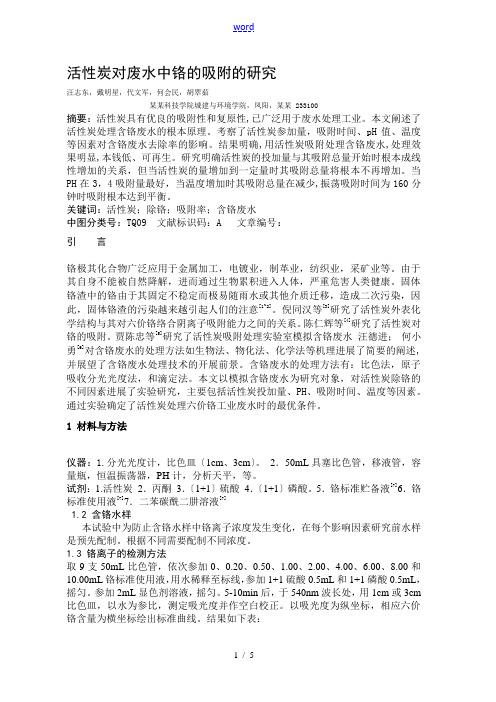
活性炭对废水中铬的吸附的研究汪志东,戴明星,代文军,何会民,胡翠茹某某科技学院城建与环境学院,凤阳,某某 233100摘要:活性炭具有优良的吸附性和复原性,已广泛用于废水处理工业。
本文阐述了活性炭处理含铬废水的根本原理。
考察了活性炭参加量,吸附时间、pH值、温度等因素对含铬废水去除率的影响。
结果明确,用活性炭吸附处理含铬废水,处理效果明显,本钱低、可再生。
研究明确活性炭的投加量与其吸附总量开始时根本成线性增加的关系,但当活性炭的量增加到一定量时其吸附总量将根本不再增加。
当PH在3,4吸附量最好,当温度增加时其吸附总量在减少,振荡吸附时间为160分钟时吸附根本达到平衡。
关键词:活性炭;除铬;吸附率;含铬废水中图分类号:TQ09 文献标识码:A 文章编号:引言铬极其化合物广泛应用于金属加工,电镀业,制革业,纺织业,采矿业等。
由于其自身不能被自然降解,进而通过生物累积进入人体,严重危害人类健康。
固体铬渣中的铬由于其固定不稳定而极易随雨水或其他介质迁移,造成二次污染,因此,固体铬渣的污染越来越引起人们的注意[1~2]。
倪同汉等[3]研究了活性炭外表化学结构与其对六价铬络合阴离子吸附能力之间的关系。
陈仁辉等[4]研究了活性炭对铬的吸附。
贾陈忠等[5]研究了活性炭吸附处理实验室模拟含铬废水汪德进;何小勇[6]对含铬废水的处理方法如生物法、物化法、化学法等机理进展了简要的阐述,并展望了含铬废水处理技术的开展前景。
含铬废水的处理方法有:比色法,原子吸收分光光度法,和滴定法。
本文以模拟含铬废水为研究对象,对活性炭除铬的不同因素进展了实验研究,主要包括活性炭投加量、PH、吸附时间、温度等因素。
通过实验确定了活性炭处理六价铬工业废水时的最优条件。
1 材料与方法仪器:1.分光光度计,比色皿〔1cm、3cm〕。
2.50mL具塞比色管,移液管,容量瓶,恒温振荡器,PH计,分析天平,等。
试剂:1.活性炭2.丙酮3.〔1+1〕硫酸4.〔1+1〕磷酸。
活性炭对六价铬的吸附研究
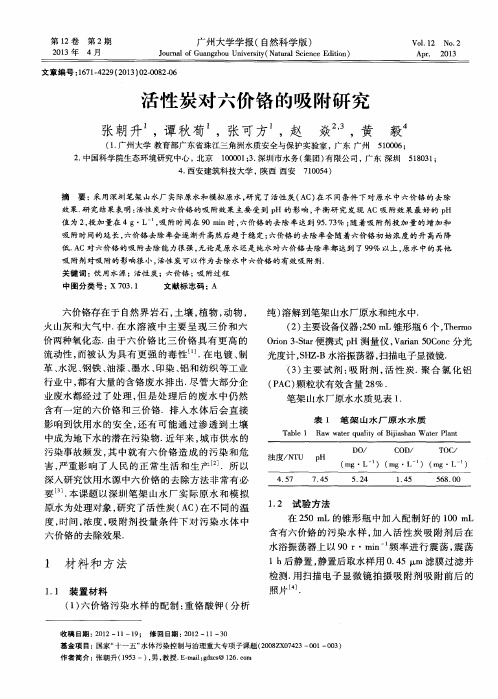
基金项 目:国家“ 十一五” 水体污染控制 与治理重大专项子课题 ( 2 0 0 8 Z X 0 7 4 2 3— 0 0 1— 0 0 3 )
表 I 笔 架 山水 厂 原 水 水 质
T a b l e 1 R a w w a t e r q u a l i t y o f B i j i a s h a n Wa t e r P l a n t
D0/ C0D/ T0C /
革、 水泥 、 钢铁 、 油漆 、 墨水 、 印染 、 铝 和 纺织 等 工业 行业 中 , 都 有 大量 的含 铬废 水 排 出. 尽管 大 部 分企 业废 水都 经 过 了处 理 , 但 是 处 理 后 的废 水 中仍 然
Vo 1 . 1 2 No . 2 Ap r . 201 3
4月
文章编号 : 1 6 7 1 — 4 2 2 9 ( 2 0 1 3 ) 0 2 附 研 究
张朝 升 , 谭秋苟 ,张 可 方 , 赵 焱2 , 黄 毅4
第 1 2卷 第 2期
201 3正
广州 大学学 报 ( 自然科 学版 )
J o u na r l o f G u a n g z h o u U n i v e r s i t y ( N a t u r a l S c i e n c e E d i t i o n )
含 有一定 的六价 铬 和 三价 铬 .排 入水 体 后 会 直 接
影 响到饮 用 水 的安 全 , 还 有 可 能通 过渗 透 到 土 壤
中成 为地下 水 的潜 在 污 染物 . 近年 来 , 城 市供 水 的 污 染事 故频 发 , 其 中 就有 六 价 铬 造 成 的 污 染 和 危 害, 严 重影 响 了 人 民 的正 常 生 活 和 生 产 .所 以 深 入研 究饮 用水 源 中六 价铬 的去 除方 法 非 常有 必 要 . 本课 题 以深 圳 笔 架 山水 厂 实 际原 水 和模 拟 原水 为处 理对 象 , 研 究 了活性 炭 ( A C) 在 不 同 的温 度, 时间, 浓度 , 吸 附剂 投 量 条 件 下 对 污染 水 体 中 六价 铬 的去 除效果 .
活性炭对六价铬的吸附研究
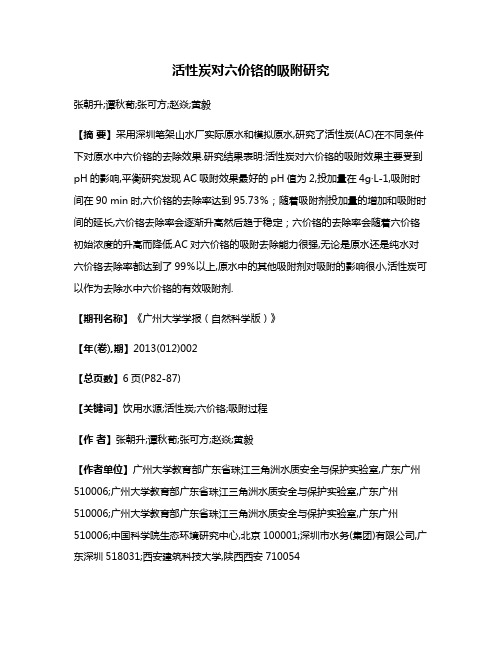
活性炭对六价铬的吸附研究张朝升;谭秋荀;张可方;赵焱;黄毅【摘要】采用深圳笔架山水厂实际原水和模拟原水,研究了活性炭(AC)在不同条件下对原水中六价铬的去除效果.研究结果表明:活性炭对六价铬的吸附效果主要受到pH的影响,平衡研究发现AC吸附效果最好的pH值为2,投加量在4g·L-1,吸附时间在90 min时,六价铬的去除率达到95.73%;随着吸附剂投加量的增加和吸附时间的延长,六价铬去除率会逐渐升高然后趋于稳定;六价铬的去除率会随着六价铬初始浓度的升高而降低.AC对六价铬的吸附去除能力很强,无论是原水还是纯水对六价铬去除率都达到了99%以上,原水中的其他吸附剂对吸附的影响很小,活性炭可以作为去除水中六价铬的有效吸附剂.【期刊名称】《广州大学学报(自然科学版)》【年(卷),期】2013(012)002【总页数】6页(P82-87)【关键词】饮用水源;活性炭;六价铬;吸附过程【作者】张朝升;谭秋荀;张可方;赵焱;黄毅【作者单位】广州大学教育部广东省珠江三角洲水质安全与保护实验室,广东广州510006;广州大学教育部广东省珠江三角洲水质安全与保护实验室,广东广州510006;广州大学教育部广东省珠江三角洲水质安全与保护实验室,广东广州510006;中国科学院生态环境研究中心,北京100001;深圳市水务(集团)有限公司,广东深圳518031;西安建筑科技大学,陕西西安710054【正文语种】中文【中图分类】X703.1六价铬存在于自然界岩石,土壤,植物,动物,火山灰和大气中.在水溶液中主要呈现三价和六价两种氧化态.由于六价铬比三价铬具有更高的流动性,而被认为具有更强的毒性[1].在电镀、制革、水泥、钢铁、油漆、墨水、印染、铝和纺织等工业行业中,都有大量的含铬废水排出.尽管大部分企业废水都经过了处理,但是处理后的废水中仍然含有一定的六价铬和三价铬.排入水体后会直接影响到饮用水的安全,还有可能通过渗透到土壤中成为地下水的潜在污染物.近年来,城市供水的污染事故频发,其中就有六价铬造成的污染和危害,严重影响了人民的正常生活和生产[2].所以深入研究饮用水源中六价铬的去除方法非常有必要[3].本课题以深圳笔架山水厂实际原水和模拟原水为处理对象,研究了活性炭(AC)在不同的温度,时间,浓度,吸附剂投量条件下对污染水体中六价铬的去除效果.1 材料和方法1.1 装置材料(1)六价铬污染水样的配制:重铬酸钾(分析纯)溶解到笔架山水厂原水和纯水中.(2)主要设备仪器:250 mL锥形瓶6个,Thermo Orion 3-Star便携式pH测量仪,Varian 50Conc分光光度计,SHZ-B水浴振荡器,扫描电子显微镜.(3)主要试剂:吸附剂,活性炭.聚合氯化铝(PAC)颗粒状有效含量28%.笔架山水厂原水水质见表1.表1 笔架山水厂原水水质Table 1 Raw water quality of Bijiashan Water Plant浊度/NTU pH DO/(mg·L-1)COD/(mg·L-1)TOC/(mg·L-1)4.57 7.45 5.241.45 568.001.2 试验方法在250 mL的锥形瓶中加入配制好的100 mL含有六价铬的污染水样,加入活性炭吸附剂后在水浴振荡器上以90 r·min-1频率进行震荡,震荡1 h后静置,静置后取水样用0.45 μm滤膜过滤并检测.用扫描电子显微镜拍摄吸附剂吸附前后的照片[4].2 结果与分析2.1 pH对吸附效果的影响研究pH对六价铬吸附的影响,AC的浓度为10 g·L-1,pH 变化范围 2 ~12.六价铬初始浓度为10 mg·L-1,通过投加0.1 mol·L-1氢氧化钠和0.1 mol·L -1盐酸调节 pH[5-7].pH 对 AC 吸附的影响如图1.图1 pH对AC去除六价铬的影响Fig.1 Effect of pH on percent removal of Cr(VI)by AC根据图1可知,AC的吸附能力随着pH值的增大而逐渐降低.pH=2时AC对六价铬的吸附能力最大(95.73%).pH<2时,铬的主要存在形式[8]:Cr3+、Cr2+、Cr.在酸性条件下 Cr3+主要以八面体六水化合物Cr(H2O)36+存在,水中基本没有六价铬的存在.当 pH>8后,铬在水中主要以存在,过碱的环境下与OH-的竞争吸附OH-占主导地位,吸附剂对六价铬去除率很低.当pH在2~8之间时,铬的主要存在形式:Cr3+、Cr2+、Cr、 C.溶液中主要会存在下列反应[8]:根据上述3个反应,当溶液中的pH较低时,H+数量较大,反应主要向着生成三价铬的方向进行,而且在酸性条件下,铬会形成较多的聚合态氧化物,同时吸附剂表面也会高度质子化,增加了对阴离子态的六价铬吸附能力.所以在酸性条件下,吸附剂对六价铬的吸附能力较强,随着pH值上升,表面质子化程度逐渐降低,平衡反应转向不利的一面,最终导致吸附量的降低[4,9].从吸附剂表面特性来说,活性炭表面存在大量的含氧基团,如羟基(-OH).活性炭不单纯是游离碳,而且是含碳量多、分子量大的有机分子凝聚体[6].在pH较低的条件下含氧基团会不断水解,并与六价铬生成相应的化合物,从而达到吸附的效果.随着pH升高,OH-浓度增加,含氧基团与OH-的亲和力大于对六价铬的亲和力.所以pH影响吸附剂对金属的吸附效果,主要与溶液中官能团的类型和离子状态相关,更与金属在溶液中的化学性质密切相关[7].通过研究发现,平衡后水样中的pH值有所变化.平衡后的pH见图2,AC的浓度为10 g·L-1,初始六价铬浓度10 mg·L-1.pH升高可以用吸附剂与溶质联合反应来解释.当在含碳物质表面的氧化合物与水接触时[4],它们会与水发生下列反应:随着反应式(1)的进行水中的OH-增多,会使得pH值上升[10].根据反应式(2)当铬离子进入溶液后会与H+发生反应,消耗掉质子而且会释放OH-到水中也会导致 pH 的升高[4,10].pH 值降低主要是由于水中OH-与吸附剂表面的阳离子发生了中和,减少了水中OH-的含量从而使水中pH趋于中性.图2 初始和平衡溶液pH值Fig.2 Initial and equilibrium solution pH2.2 吸附剂量对吸附效果的影响选取AC最佳投加量的吸附试验研究,六价铬的初始浓度为10 mg·L-1,AC 投加量 2、4、6、8、10、12、15、20 g·L-1.图3 投加量对六价铬吸附影响Fig.3 Effect of dose on Cr(VI)adsorption从图3可见,吸附剂AC对六价铬的吸附能力和投加量的增加成正比,投加量在4 g·L-1时去除率99.01%,之后就趋于稳定.在投加量1~4 g·L-1之间时,吸附效果随着吸附剂量的增加而增大的原因是由于吸附剂表面积的增加[4].4 g·L-1是AC投加量的最优值.2.3 吸附时间对效果的影响吸附时间 5、10、20、40、80、100、120、240 min,六价铬浓度为10 mg·L -1.图4 接触时间对六价铬去除的影响Fig.4 Effect of time on Cr(VI)removal试验结果见图4,吸附剂对六价铬的吸附速率在初始阶段很大,然后逐渐降低,在90 min时AC对六价铬的去除率达到95.73%,90~240 min去除率变化很小,AC对六价铬去除率只上升了3.28%,造成这种结果主要是由于开始吸附时,吸附剂表面有大量有效吸附位点可供吸附,由于溶质分子和吸附剂表面之间的排斥力,达到最佳吸附量后剩下来的空白表面就很难再有吸附能力了[11-12].在最佳时间之后吸附量基本不再改变,故将90 min作为AC的最佳接触时间.2.4 铬初始浓度对吸附效果的影响图5为AC对不同初始浓度铬的吸附效果.图5 初始浓度对去除六价铬的影响Fig.5 Effect of initial concentration on percent removal of Cr(VI)在试验中选取六价铬初始浓度为1、3、5、10、20、30、50 mg·L-1.试验结果表明,六价铬的去除率随着六价铬加入量的升高而降低.AC对六价铬的去除率为99.37% ~84.62%.这主要是由于在吸附剂和六价铬浓度较低的时候,六价铬被高能量位点所吸附.随着金属离子吸附速率上升,高能力位点会被充满,然后吸附开始转向低能量位点,从而导致吸附效率下降[4,13].2.5 吸附前后孔隙特征对比图6为AC吸附前后的电镜扫描图片.图6 电镜扫描图(上图吸附前,下图吸附后)Fig.6 Electron microscopescans(Top:before adsorption;Below:after adsorption)试验是由纯水配制水样,AC投加量为4 g·L-1,六价铬的去除率为95.91%.AC表面像是由许多薄片重叠构成的,孔隙繁多,其表面积巨大.由外向内分为大孔、中孔、小孔,大孔为主要通道,主要起吸附作用的是小孔.在吸附平衡后,AC的孔隙基本被占据,吸附的物质附着在AC表面,表面的多孔结构也变得比较平滑. 2.6 不同水质条件下的吸附对比为了解原水中的其他物质对六价铬吸附过程的干扰情况,在各种条件均与纯水试验相同的情况下,又进行了原水和纯水的对比试验.研究了AC的吸附速度和吸附容量.图7是AC对两种水样的效果和速度的对比.从图7可见,AC对原水配制的水样中的六价铬去除率和纯水保持一致,原水中所包含杂质对六价铬的吸附几乎没有产生影响.两条曲线在吸附90 min后吸附基本达到平衡,之后变化不大.对比两条曲线,可以发现在5 min的时候原水的去除率比纯水的去除率高10.63%,而且在20~90 min原水的去除率都略高于纯水,在此之后二者去除率趋于一致.这一现象可以通过以下原因来解释:AC对铬的吸附速率由4个连续的步骤所控制[14]:①在总溶液中扩散;②通过液相边缘扩散到吸附微粒表面;③空隙所包含液体和沿着孔壁的吸附物上发生的颗粒内部扩散;④颗粒内部和外表发生吸附和解吸.这4个步骤都有可能控制吸附速度.其中两种水质在步骤③有差异,纯水中吸附质单一,原水中存在多种吸附质,在六价铬浓度相同的条件下,原水中AC的孔壁所吸附的吸附物相对较多,六价铬离子向内部的扩散速度较快,而且AC颗粒表面吸附位点非常丰富,原水中其他物质的吸附竞争可以忽略. 图7 AC的吸附速度对比Fig.7 Comparison of adsorption rate of AC图8是AC对两种水样的吸附容量对比,AC对六价铬的吸附去除能力很强,无论是原水还是纯水去除率都达到了99%以上,原水中的其他吸附质对吸附的影响很小.图8 AC的吸附容量对比Fig.8 Comparison of adsorption capacity of AC2.7 纯水与原水条件下AC吸附后表面特征对比图9 AC吸附后电镜扫描图(上图纯水,下图原水)Fig.9 AC Electron microscope scans after adsorption(Top:pure water;Below:raw water)图9为AC吸附后两种水样的电镜扫描图片.AC投加量为4 g·L-1,纯水与原水条件下六价铬的去除率分别为95.91%和98.1%.对比两幅图发现原水吸附后的表面的孔隙度明显比纯水吸附后的表面丰富,而且吸附在纯水条件下AC的表面的颗粒比较均匀且细小,在原水条件下吸附后AC的表面既有细微颗粒也有较大的颗粒. 这种现象正好解释了上面所提到的影响吸附速度4个连续步骤中的第③步的问题.由于AC表面吸附的吸附质较多,提高了六价铬离子向吸附剂内部扩散的速度,从而增大了六价铬的去除率.3 结论(1)活性炭对六价铬的吸附过程受pH值影响最大,pH越低吸附效果越好,吸附最佳pH值为2.但是在实际应用中,考虑到原水中的pH值接近中性,吸附时宜将pH控制在6~7的范围.(2)活性炭对六价铬的吸附随着吸附剂量和吸附时间的增加而先升高再逐渐稳定.(3)六价铬初始浓度越大,吸附效果越差.(4)原水中的其他吸附质对吸附的影响很小.参考文献:[1] SHARMA D C,CHATTERJEE C,SHARMA C P.Chromium accumulation and its effects on wheat metabolism[J].Plant Sci,1995,111(1):145-151.[2]张晓健.加强城市供水应急处理技术和应急系统建设的研究[J].给水排水,2007,33(11):1.ZHANG X J.Strengthen the urban water supply emergency response technology and construction of emergency response system[J].Water Wastewat Eng,2007,33(11):1.[3]陶光华,陆少鸣,王健.饮用水源突发性铬污染去除方法的比较研究[J].环境工程学报,2010,4(1):133-136.TAO G H,LU S M,WANG parative study on elimination methods for unexpected chromium pollution in drinking water sources[J].Chin J Environ Eng,2010,4(1):133-136. [4]谭秋荀,张可方,赵焱,等.活性氧化铝对六价铬的吸附研究[J].环境科学与技术,2012,35(6):130-133.TAN Q X,ZHANG K F,ZHAO Y,etal.Adsorption of hexavalent chromium by activated alumina[J].Environ Sci Tech,2012,35(6):130-133.[5] LOTFI K,RICHARD C.Removal of chromium(VI)from aqueous solution by activated.carbons:Kinetic and equilibrium studies[J].J Hazardous Mater,2005,123(1-3):223-231.[6] K.SELVI.S.PATTABHI K K.Removal of Cr(VI)from aqueous solution by adsorption onto activated carbon[J].Elsevier,2001,80(1):87-89. [7] GUPTA V K,SHRIVASTAVA A K,JAIN N.Biosorption of chromium(VI)from aqueous solutions by green algae spirogyra species [J].Water Res,2001,35(17):4079-4085.[8] BERT M.WECKHUYSEN I E W A.Surface Chemistry and Spectroscopy of Chromium in Inorganic Oxides[J].Chem Rev,1996,96(1/4):3327-3349.[9] SELVI K P S K.Removal of Cr(VI)from aqueous solution by adsorption onto activated carbon[J].Biores Tech,2000,80(2):87-89.[10]MOR S,RAVINDRA K,BISHNOI N R.Adsorption of chromium from aqueous solution by activated alumina and activated charcoal[J].BioresTech,2007,98(4):954-957.[11] CHAND S.Removal of Cr(VI)from wastewater by adsorption[J].Indian J Environ Heal,1999,41(1):151-158.[12] SARAVANANE R S T S.Efficiency of chemically modified low cost adsorbents for the removal of heavy metals from wastewater[J].Indian J Environ Heal,2002,44(3):78-81.[13] KADIRVELU C N.Activated carbon from coconut coirpitch as metal adsorbent:adsorption of Cd(II)from aqueous solution[J].Adv Environ Res,2003,7(2):471-478.[14]DINESH M,CHARLES U P.Activated carbons and low cost adsorbents for remediation of tri-and hexavalent chromium from water [J].J Hazardous Mater,2006,137(3):762-811.。
吸附法去除水中六价铬的研究进展

本次演示旨在探讨玉米秸秆的改性及其对六价铬离子吸附性能的影响。近年 来,随着环境污染问题的日益严重,寻找高效、环保的污染治理材料已成为研究 热点。玉米秸秆作为一种丰富的生物资源,具有很好的应用前景。本次演示将介 绍玉米秸秆的改性方法及其对六价铬离子吸附性能的影响,为环境保护和污染治 理提供新的思路。
三、研究进展
近年来,研究人员针对皮革中六价铬的测定方法进行了大量研究。在样品处 理技术方面,研究者们探索了各种样品预处理方法,如超声波辅助萃取、加速溶 剂萃取、微波辅助萃取等,以提高样品的提取效率和测定准确性。在测定方法与 标准方面,分光光度法、电化学法、色谱法、原子吸收光谱法等都有应用报道, 但各方法之间的准确性和重复性存在差异。
综上所述,玉米秸秆的改性及其对六价铬离子吸附性能的研究具有重要的理 论和实践意义。通过改性处理,可以提高玉米秸秆对六价铬离子的吸附能力,从 而有效治理环境污染。然而,仍需进一步研究以完善改性条件和评估其在实际环 境中的应用效果。
一、引言
随着工业和农业的快速发展,水体中重金属离子污染的问题日益严重。这些 重金属离子,如铅、汞、镉等,对环境和人类健康构成严重威胁。因此,开发有 效的重金属离子去除技术成为当前研究的热点。海藻酸钠基吸附材料由于其独特 的物理化学性质,如高吸附容量、快速吸附等,在水体重金属离子去除领域具有 广阔的应用前景。本次演示将综述海藻酸钠基吸附材料去除水中重金属离子的最 新研究进展。
最后,在实际应用中,如何实现高效、环保的六价铬去除仍需考虑许多实际 问题。例如,如何实现大批量生产高品质的吸附剂;如何在保证去除效果的同时 降低运行成本;如何合理规划设计水处理流程等问题都需要在实际应用中进行深 入研究和探讨。
总结:
本次演示介绍了吸附法去除水中六价铬的基本原理和影响因素,并展望了未 来的研究方向。尽管该领域已经取得了一定的进展,但仍有许多问题需要进一步 研究和探讨。希望通过不断的研究和实践探索,进一步推动该领域的发展并提高 实际应用中的处理效果和效率。
《废菌渣活性炭对水中Cr(Ⅵ)吸附及再生研究》范文
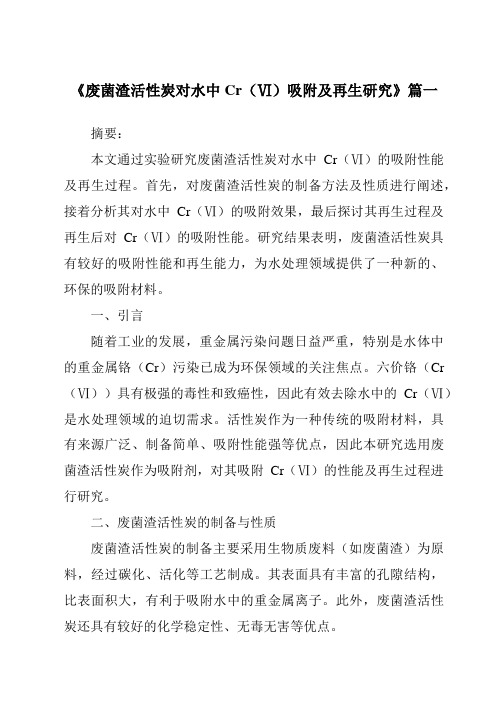
《废菌渣活性炭对水中Cr(Ⅵ)吸附及再生研究》篇一摘要:本文通过实验研究废菌渣活性炭对水中Cr(Ⅵ)的吸附性能及再生过程。
首先,对废菌渣活性炭的制备方法及性质进行阐述,接着分析其对水中Cr(Ⅵ)的吸附效果,最后探讨其再生过程及再生后对Cr(Ⅵ)的吸附性能。
研究结果表明,废菌渣活性炭具有较好的吸附性能和再生能力,为水处理领域提供了一种新的、环保的吸附材料。
一、引言随着工业的发展,重金属污染问题日益严重,特别是水体中的重金属铬(Cr)污染已成为环保领域的关注焦点。
六价铬(Cr (Ⅵ))具有极强的毒性和致癌性,因此有效去除水中的Cr(Ⅵ)是水处理领域的迫切需求。
活性炭作为一种传统的吸附材料,具有来源广泛、制备简单、吸附性能强等优点,因此本研究选用废菌渣活性炭作为吸附剂,对其吸附Cr(Ⅵ)的性能及再生过程进行研究。
二、废菌渣活性炭的制备与性质废菌渣活性炭的制备主要采用生物质废料(如废菌渣)为原料,经过碳化、活化等工艺制成。
其表面具有丰富的孔隙结构,比表面积大,有利于吸附水中的重金属离子。
此外,废菌渣活性炭还具有较好的化学稳定性、无毒无害等优点。
三、废菌渣活性炭对水中Cr(Ⅵ)的吸附研究(一)实验方法本实验采用静态吸附法,将废菌渣活性炭与含Cr(Ⅵ)的水溶液混合,在一定温度下进行吸附实验。
通过改变活性炭的投加量、溶液pH值、温度等条件,研究各因素对吸附效果的影响。
(二)实验结果与分析实验结果表明,废菌渣活性炭对水中Cr(Ⅵ)具有良好的吸附性能。
随着活性炭投加量的增加和溶液pH值的降低,Cr(Ⅵ)的去除率逐渐提高。
此外,温度对吸附效果也有一定影响,一般在一定范围内温度升高有利于提高吸附速率和去除率。
通过SEM、BET等手段对吸附后的活性炭进行表征分析,发现其表面有明显的Cr(Ⅵ)沉积现象,表明其具有良好的吸附能力。
四、废菌渣活性炭的再生研究为了降低生产成本和延长废菌渣活性炭的使用寿命,本部分对其再生过程进行研究。
活性炭对水中Cr(Ⅵ)吸附行为的研究
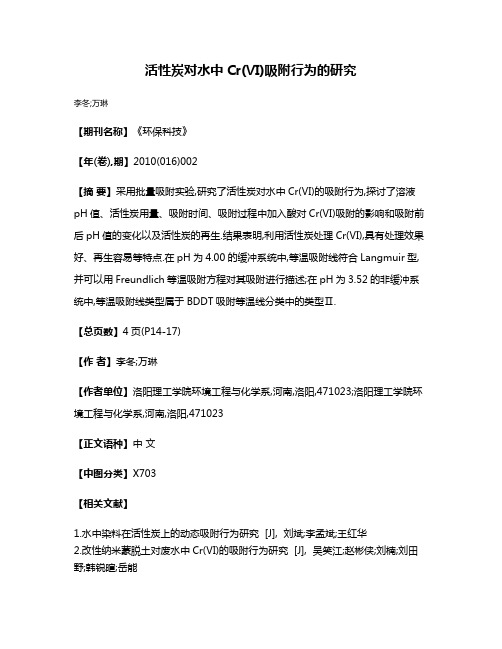
活性炭对水中Cr(Ⅵ)吸附行为的研究
李冬;万琳
【期刊名称】《环保科技》
【年(卷),期】2010(016)002
【摘要】采用批量吸附实验,研究了活性炭对水中Cr(Ⅵ)的吸附行为,探讨了溶液pH值、活性炭用量、吸附时间、吸附过程中加入酸对Cr(Ⅵ)吸附的影响和吸附前后pH值的变化以及活性炭的再生.结果表明,利用活性炭处理Cr(Ⅵ),具有处理效果好、再生容易等特点.在pH为4.00的缓冲系统中,等温吸附线符合Langmuir型,并可以用Freundlich等温吸附方程对其吸附进行描述;在pH为3.52的非缓冲系统中,等温吸附线类型属于BDDT吸附等温线分类中的类型Ⅱ.
【总页数】4页(P14-17)
【作者】李冬;万琳
【作者单位】洛阳理工学院环境工程与化学系,河南,洛阳,471023;洛阳理工学院环境工程与化学系,河南,洛阳,471023
【正文语种】中文
【中图分类】X703
【相关文献】
1.水中染料在活性炭上的动态吸附行为研究 [J], 刘斌;李孟斌;王红华
2.改性纳米蒙脱土对废水中Cr(Ⅵ)的吸附行为研究 [J], 吴笑江;赵彬侠;刘楠;刘田野;韩锐暄;岳能
3.水中Cr(VI)在不同性质黑炭上的吸附行为研究 [J], 陈利芳; 王炼; 朱强; 周腾腾
4.改性夏威夷壳炭对废水中Cr(Ⅵ)的吸附行为研究 [J], 徐冰冰;江琳琳;张建华;张甜;黄刚;许楷
5.沥青基活性炭纤维对水中三价金离子吸附行为的研究 [J], 凌立成;刘朗;钱树安因版权原因,仅展示原文概要,查看原文内容请购买。
活性炭还原铬水调研小结

高浓度铬水处理方法研究——活性炭篇1、研究目的目前常用还原剂进行六价铬还原反应时都要消耗大量H+,因而还原pH值越低,还原速率越快,还原六价铬越彻底;当pH值高时,投药比会加大,残存还原剂还会造成排水COD上升而超标。
六价铬还原前大量投酸,而沉淀重金属又要大量投碱(特别对中和沉淀法),仅此一项就提高了废水处理的成本(特别对六价铬的质量浓度本就不高的混合废水),故开展“高浓度铬水处理方法研究”希望达到降低六价铬还原成本和减少硫酸根加入量的目的。
2、不同还原铬水方法需氢离子量(1)当pH<3时,活性炭具有还原性,可将吸附在其表面的Cr6+还原为Cr3+,化学反应方程式:2Cr2O72-+3C+16H+=3CO2↑+4Cr3++8H2O;(2)双氧水还原六价铬方程式:2Cr2O72-+6H2O2+16H+=4Cr3++14H2O+6O2↑;(3)焦亚还原六价铬方程式:2Cr2O72-+3S2O52-+10H+=4Cr3++6SO42-+5H2O;(4)硫酸亚铁还原六价铬方程式:2Cr2O72-+12Fe2++28H+=4Cr3++12Fe3++24H2O;由以上四个方程式可得:活性炭和双氧水破除一个重铬酸根均需要8个H+,而焦亚破除一个重铬酸根只需5个H+,故明显活性炭和双氧水还原六价铬所需的pH值要低于焦亚的。
而硫酸亚铁还原六价铬比较特殊,尽管从化学方程式看硫酸亚铁还原六价铬需要更低的pH值,但是由于氢氧化铁的溶度积小,在pH=3左右即基本沉淀完全,故结合了大量OH-,释放出较多H+,双重促进反应向右进行,导致实际使用硫酸亚铁还原六价铬时的pH并不需要很低。
3、活性炭吸附法文献调研活性炭去除六价铬的主要机理如下:由于活性炭的特殊结构和特性,有极强的吸附力,它对铬的有效吸附有以下几种情况。
(1)物理吸附,由于活性炭有极微的微孔,利用活性炭表面微孔,使吸附质Cr2O72-通过大孔通道扩散到过渡孔和小孔中去,完成吸附过程。
活性炭纤维对水中铬(Ⅵ)离子的吸附研究
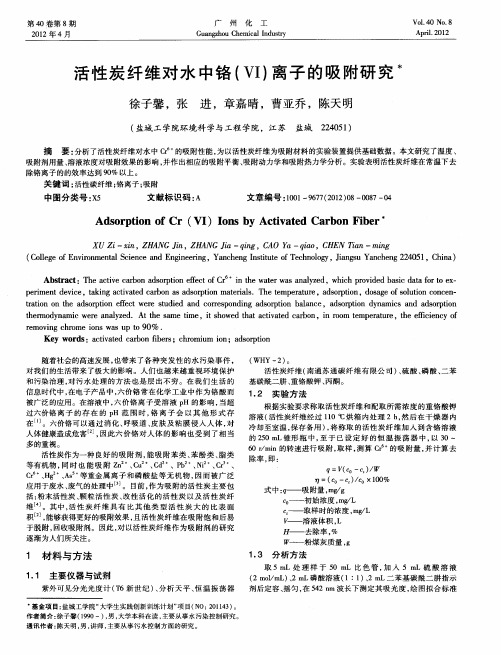
随着社会的高速发展 , 也带来 了各种突发性 的水 污染事件 , 对我们 的生活带来 了极大 的影响 。人们也 越来越重 视环境保 护 和污染治理 , 污水处 理 的方 法也 是层 出不穷 。在 我们 生活 的 对 信息时代 中, 电子产 品中 , 在 六价铬常在化 学工业 中作为铬 酸而 被广泛 的应用 。在溶液中 , 六价铬 离子 受溶液 p 的影 响 , H 当超 过六价铬 离 子 的存 在 的 p 范 围 时 , 离 子 会 以其 他 形 式 存 H 铬 在… 。六价铬可以通过 消化 、 吸道 、 肤及粘 膜侵 入人 体 , 呼 皮 对 人体健康造成危害 J 因此六 价铬对 人体 的影 响也受 到 了相 当 ,
多的重视 。 活性炭作为一种 良好 的吸附剂 , 能吸 附苯类 、 酚类 、 类 苯 脂 等有机物 , 时也 能 吸 附 z “ 、 u 、 d 、P “ 、 i 、 r 同 n c“ c“ b N“ c 3 、
C6 r
、
( WHY 一2 )。
活性炭纤维 ( 南通苏 通碳纤 维有 限公 司) 硫 酸 、 、 磷酸 、 二苯 基碳酰二肼 、 重铬酸钾 、 丙酮。
,
pe me td vc i r n e i e,tk n cia e a b n a d o p in mae as a i g a tv td c r o sa s r to tr l .Th e e au e,a o to i e tmp r t r ds r i n,d s g fs l to o c n p o a eo ou in c n e — tai n o h ds r to fe twe e sud e n o r s o i g a o to a a c r to n t e a o i n ef c r t id a d c re p nd n ds r i n b ln e,a s r t n d n mis a d a s r to p p d o i y a c n do in p o p t e mo y a c we e a ay e h r d n mi r n l z d.Att e s me t h a i me,i h we h ta t a e abo ts o d t a c i td c r n,i o m e e au e,t e efce c f v n r o t mp r t r h f in y o i r mo i g c r me in s u o 9 e vn h o o s wa p t 0% . Ke y wor ds:a t ae a b n f r ;c r mi m o c i t d c r o be s h o u in;a s r t n v i do i p o
活性炭吸附处理实验室含Cr(Ⅵ)废水的研究

2 1 ,2 ( ) 3— 5 0 0 9 2 :5 5
C5 N 3一l0 / IS 17 9 5 2 5 X S N 6 3— 6 5
活 性 炭 吸 附 处 理 实验 室含 C ( I 废 水 的研 究 r V)
李 冬 ,席 晓 晶 ( 阳理 工学 院环境 工程 与 化学 系 ,河南 洛 阳 4 12 ) 洛 703 摘 要 :采 用静 态和 动 态吸 附 实验 ,探 讨 了溶 液 p H值 、活性 炭 用量 对 c V ) 吸 附的影 响 以及 活性 r( I
吸附到 多分 子层吸 附 的转 变 。
用 ,吸附后溶 液 中 铬 以 C V ) 的形 式 存 在 ,吸 r( I 附去除 率 随着 p 值 的 升 高 而 下 降 ,吸 附 后 溶 液 H
附前后 溶 液 中 C V ) 的 浓 度 ,计 算 其 去 除 率 。 r( I
总 铬测 定 采 用 高 锰 酸 钾 氧 化 一二 苯 碳 酰 二 肼 比 色法。 动 态 吸 附 实 验 :称 取 一 定 量 的 粒 状 活 性 炭 装 柱 ,让含 C V ) 废 水 从 上 而 下 流 过 活性 炭 ,定 r( I 量 采样 ,测 定 C V ) 和 总铬 的浓度 。 r( I
段 时 间后 过 滤 ,然后 用二 苯 碳酰 二肼 比色 法测 定 吸
,
总 铬 和 六 价 铬被 《 水 综 合 排 放 标 准》 污
( B 9 8—19 ) 指定 为第 一类 污 染 物 ,规 定 了总 G 87 96
铬 的最 高 允许 排放 浓度 为 15 g L . m / ,六 价铬 的最 高 允许 排放 浓度 为 0 5 g L .m/ 。 化 学 实验 室也 产生 少量 的含 铬 废水 ,如 分 析化
载铁改性活性炭对溶液中六价铬[Cr(VI)]的吸附研究
![载铁改性活性炭对溶液中六价铬[Cr(VI)]的吸附研究](https://img.taocdn.com/s3/m/018a9d1dba68a98271fe910ef12d2af90242a8df.png)
载铁改性活性炭对溶液中六价铬[Cr(VI)]的吸附研究马欢欢;马叶;周建斌【摘要】With the progress of society and the development of modern industry, industrial "three wastes" emissions continued to increase, which brought great threat to the development of ecological environment.It caused people's survival environment to deteriorate continuously.The primary typical pollutant in chromium-containing waste water was hexavalent chromium [Cr (Ⅵ)].Different iron salt solution impregnating phosphoric acid activated carbon (Fe-PAC) was adopted, investigated the adsorption of Cr (Ⅵ) in the water.The factors of iron salt solution concentration, pH of solution, and adsorption equilibrium time, adsorption kinetics were studied.The physicochemical properties of modified activated carbon were analyzed using XPS and BET.The results showed that: modification of activated carbon by ferrous sulfate solution was chose to adsorb Cr (Ⅵ).The activated carbon adsorption capacity of Cr (Ⅵ) after the modified carrier from 10.18 mg/g up to 22.56 mg/g.Removal efficiency of Cr (Ⅵ) reached 95% while the pH of solution was at 2.0.The XPS result showed that there were divalent iron oxide and ferric oxide in the surface of activated carbon.Adsorption process was in line with the pseudo second order equation and dominated by chemical adsorption.By using nitrogen adsorption isotherm, the results showed that the specific surface area of the activated carbon decreased, because the pores of activated carbon were been blocked by iron oxide.%以磷酸法活性炭(PAC)为原料,通过不同铁盐溶液浸渍法制备载铁改性活性炭(Fe-PAC),采用二苯碳酰二肼分光光度法检测其对水中Cr(Ⅵ)的吸附效果,考察了铁盐浓度、溶液pH等因素对吸附效果的影响,研究了吸附平衡时间、吸附动力学,利用XPS、BET等方法对改性活性炭进行表征.结果表明:硫酸亚铁溶液浸渍改性活性炭对Cr(Ⅵ)吸附最佳,硫酸亚铁溶液浓度为0.20 mol/L,载铁改性后活性炭对水中Cr(Ⅵ)的吸附量从10.18 mg/g提高到22.56mg/g;溶液pH为2.0时,Cr(Ⅵ)去除率达到95%.通过XPS检测改性后活性炭表面负载有二价铁及三价铁氧化物;吸附动力学实验表明改性活性炭对Cr(Ⅵ)的吸附符合伪二级动力学方程,以化学吸附占主导.采用氮气吸附等温线对其比表面积及孔隙分布分析,结果表明由于铁氧化物堵塞孔隙,改性后活性炭的比表面积减小.【期刊名称】《科学技术与工程》【年(卷),期】2017(017)009【总页数】6页(P91-96)【关键词】载铁活性炭;六价铬;吸附;动力学【作者】马欢欢;马叶;周建斌【作者单位】南京林业大学材料科学与工程学院,南京 210037;南京林业大学化学工程学院,南京 210037;南京林业大学材料科学与工程学院,南京 210037【正文语种】中文【中图分类】X75随着社会的进步和现代工业的发展,工业三废的排放不断增加,对生态环境的可持续发展带来极大的威胁,造成人们的生存环境不断恶化。
改性活性炭吸附水中六价铬离子的研究

改性活性炭吸附水中六价铬离子的研究改性活性炭吸附水中六价铬离子的研究一、引言六价铬(Cr(Ⅵ))是一种常见的重金属离子,在工业废水和自然水环境中广泛存在。
它具有高毒性和持久性,对人体和环境造成严重危害。
因此,寻找高效、低成本的方法去除水中的六价铬离子具有重要的意义。
改性活性炭作为一种广泛应用于废水处理中的吸附剂,被广泛研究和应用于六价铬离子的去除。
二、改性活性炭的特性活性炭具有较大的比表面积和丰富的孔结构,能够通过物理或化学吸附的方式去除水中的污染物。
而改性活性炭在一般活性炭的基础上,通过改变表面性质和孔结构,提高吸附能力和选择性,进而提高去除效率和降低成本。
三、改性活性炭对六价铬离子的吸附机制改性活性炭对六价铬离子的吸附机制主要包括化学吸附和物理吸附两种方式。
1. 化学吸附改性活性炭表面携带相应的官能团,如羟基(-OH)、氨基(-NH2)和酸基(-COOH)等,可以与六价铬离子进行化学键形成络合物。
这种化学吸附能力提高了改性活性炭对六价铬离子的选择性吸附能力。
2. 物理吸附改性活性炭孔隙结构提供了大量的吸附位点,可以直接吸附并固定六价铬离子。
活性炭的微孔和介孔能够增加接触面积和扩散通道,进一步提高六价铬离子的吸附速率和容量。
四、影响改性活性炭吸附六价铬离子的因素1. pH值pH值是影响改性活性炭吸附六价铬离子的重要因素。
通常情况下,酸性条件下(pH低于等于2),六价铬离子主要以Cr2O7 2-的形式存在,吸附效果较好。
而在碱性条件下(pH大于等于6),六价铬离子主要以CrO4 2-的形式存在,吸附效果较差。
2. 吸附剂用量改性活性炭的用量直接影响着吸附效果。
适量的改性活性炭用量可以提高吸附速率和容量,但过量的用量可能会导致系统流动阻力增加和吸附效果下降。
3. 初始六价铬离子浓度初始六价铬离子浓度是影响吸附效果的重要因素。
一般来说,初始浓度较高时,吸附速率较快,但随着吸附过程的进行,吸附容量会饱和并逐渐下降。
活性炭和改性活性炭对六价铬吸附行为的研究
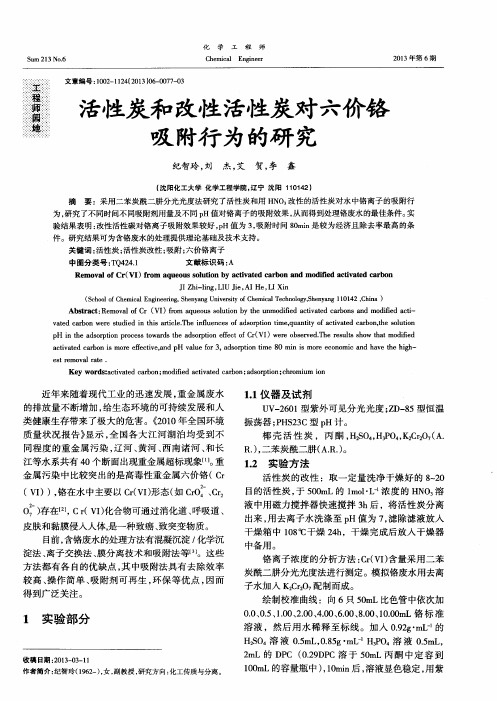
件 。研究结果可为含铬废水的处理提供理论基础及技术支持 。
关键词 :活性炭 ;活性炭改性 ;吸附 ;/一X价铬离子
中图分类号 :TQ424.1
文献标识码 :A
Removal of Cr(VI)from aqueous solution by activated carbon and modified activated carbon
铬 离 子浓 度 的分 析方 法 :Cr(VI)含 量 采用 二 苯 炭 酰二 肼分 光光 度法进 行测 定 。模拟 铬废水 用去 离 子 水加 人 KECr20,配 制而成 。
绘制校准曲线 :向 6只 50mL比色管中依次加 0.0、0.5、1.00、2.00、4.00、6.00、8.00、10.00mL铬 标 准 溶液 ,然后用水稀释 至标 线。加人 0.92g·mL--的 H2SO4溶 液 0.5mL,0.85g·mL- H3PO4溶 液 0.5mL, 2mL的 DPC (0.29DPC溶 于 50mL丙 酮 中 定 容 到 100mL的容量瓶 中),10min后 ,溶液显色稳定 ,用紫
化 学 工 程 师 Chemical Engineer
文章编号 :1002—1 124(2013)06—0077—03
誓
稔 活性 炭 和 改性 活性 炭 对 六
罔
地
吸 附行 为 的研 究
2013年第 6期
纪智玲 ,刘 杰 ,艾 贺,李 鑫
(沈阳化工大学 化学工程学院。辽宁 沈 阳 11O142)
近年 来 随着 现 代工 业 的 迅速 发展 ,重 金 属废 水 的排 放 量不 断 增 加 ,给生 态 环境 的可持 续 发 展 和人 类健康生存带来 了极大的危害。(2010年全 国环境 质量状况报告》显示 ,全 国各大江河湖泊均受到不 同程 度 的重 金 属 污 染 ,辽 河 、黄 河 、西南 诸 河 、和 长 江等 水 系共有 40个 断 面 出现 重金 属超 标现 象¨】。重 金属 污染 中 比较 突 出 的是 高毒性 重 金属 六价 铬 (Cr (vI)),铬在水中主要以 Cr(VI)形态(如 CrO:、Cr2 0:)存在f21,C r(VI)化合物可通过消化道 、呼吸道、 皮 肤 和黏 膜侵 人人 体,是一 种致 癌 、致 突 变物质 。
花生壳活性炭对六价铬的吸附
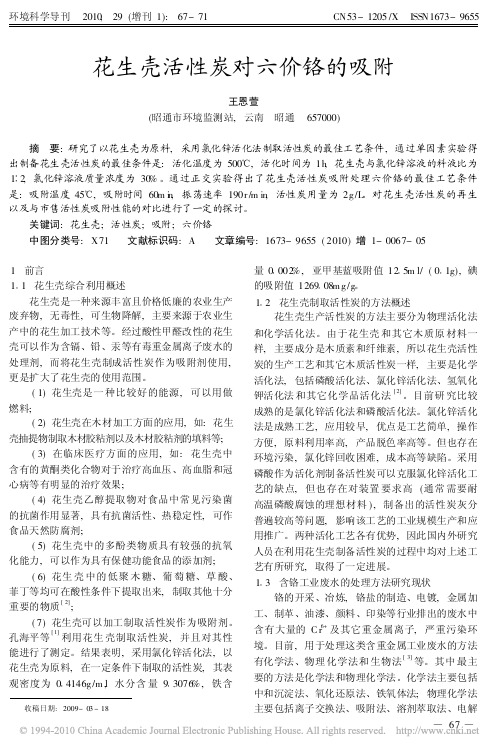
收稿日期:2009-03-18花生壳活性炭对六价铬的吸附王恩萱(昭通市环境监测站,云南 昭通 657000)摘 要:研究了以花生壳为原料,采用氯化锌活化法制取活性炭的最佳工艺条件,通过单因素实验得出制备花生壳活性炭的最佳条件是:活化温度为500 ,活化时间为1h ,花生壳与氯化锌溶液的料液比为1 2,氯化锌溶液质量浓度为30%。
通过正交实验得出了花生壳活性炭吸附处理六价铬的最佳工艺条件是:吸附温度45 ,吸附时间60m i n ,振荡速率190r /m in ,活性炭用量为2g /L 。
对花生壳活性炭的再生以及与市售活性炭吸附性能的对比进行了一定的探讨。
关键词:花生壳;活性炭;吸附;六价铬中图分类号:X71 文献标识码:A 文章编号:1673-9655(2010)增1-0067-051 前言1 1 花生壳综合利用概述花生壳是一种来源丰富且价格低廉的农业生产废弃物,无毒性,可生物降解,主要来源于农业生产中的花生加工技术等。
经过酸性甲醛改性的花生壳可以作为含镉、铅、汞等有毒重金属离子废水的处理剂,而将花生壳制成活性炭作为吸附剂使用,更是扩大了花生壳的使用范围。
(1)花生壳是一种比较好的能源,可以用做燃料;(2)花生壳在木材加工方面的应用,如:花生壳抽提物制取木材胶粘剂以及木材胶粘剂的填料等;(3)在临床医疗方面的应用,如:花生壳中含有的黄酮类化合物对于治疗高血压、高血脂和冠心病等有明显的治疗效果;(4)花生壳乙醇提取物对食品中常见污染菌的抗菌作用显著,具有抗菌活性、热稳定性,可作食品天然防腐剂;(5)花生壳中的多酚类物质具有较强的抗氧化能力,可以作为具有保健功能食品的添加剂;(6)花生壳中的低聚木糖、葡萄糖、草酸、菲丁等均可在酸性条件下提取出来,制取其他十分重要的物质[2];(7)花生壳可以加工制取活性炭作为吸附剂。
孔海平等[1]利用花生壳制取活性炭,并且对其性能进行了测定。
结果表明,采用氯化锌活化法,以花生壳为原料,在一定条件下制取的活性炭,其表观密度为0 4146g /m ,l 水分含量9 3076%,铁含量0 002%,亚甲基蓝吸附值12 5m l/(0 1g),碘的吸附值1269 08m g /g 。
活性炭对水中六价铬的吸附研究

活性炭对水中六价铬的吸附研究摘要六价铬是公认的致癌物质,对人体健康危害极大,目前主要采用吸附法进行去除。
活性炭是常用的吸附剂,通过硝酸改性可以增加活性炭表面的酸性官能团,提高去除效果。
研究活性炭的投加量,吸附时间,温度,PH值等因素对六价铬去除率的影响。
绘制吸附等温线,和吸附模型进行拟合,分析吸附机理。
关键词活性炭改性硝酸六价铬吸附冶金,电镀,制革,印染,制药等行业排出大量金属废水,危害人类健康。
废水中的Cr(Ⅵ)是一种强氧化剂,具有强致癌,致畸变,致突变作用,对生物危害极大。
Cr(Ⅵ)属于第一类污染物,必须经处理达标才能排放。
目前对含Cr废水的处理研究较多,主要有生物法,离子交换法,还原法,膜分离法,吸附法等。
活性炭吸附法处理含Cr废水的效果稳定,且价格相对较低,但普通活性炭的吸附量不高,因此本试验研究以硝酸改性活性炭为研究对象,通过研究其在不同的PH,温度,投加量以及吸附时间条件下对Cr(Ⅵ)的吸附效果,以确定最佳吸附条件。
1、实验部分1.1 试剂和仪器活性炭、丙酮、(1+1)硫酸、(1+1)磷酸、铬标准储备液、铬标准液、二苯碳酰二肼溶液、硝酸恒温水浴、干燥恒温箱、分析天平、分光光度计、恒温水浴振荡器1.2 溶液配制本实验中为防止含铬水样中铬离子浓度发生变化,在每个影响因素研究前水样是预先配置的。
根据不同需要配置不同浓度。
1.2.1 铬标准储备液称取0.283g重铬酸钾置于烘箱中烘干2h。
将烘好的重铬酸钾倒入100ml烧杯中,再倒入适量的蒸馏水。
搅拌至完全溶解。
将重铬酸钾溶液移入1000ml容量瓶中,再水稀释至标线,摇匀,备用。
1.2.2 铬标准溶液吸取5.00ml铬标准储备溶液置于500ml容量瓶中,用水稀释至标线,摇匀,备用。
1.2.3 硫酸溶液用25ml的移液管移取浓硫酸50ml,缓缓加入到同体积的水中,摇匀,备用。
1.2. 磷酸溶液用25ml的移液管移取磷酸50ml,加入到同体积的水中,摇匀,备用。
改性活性炭吸附水中六价铬离子的研究
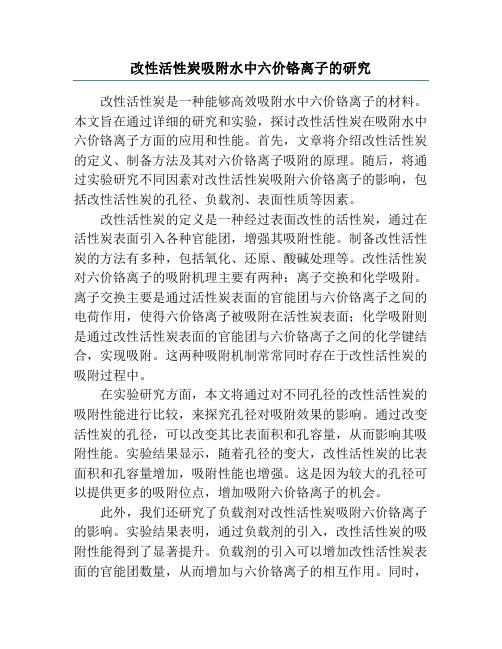
改性活性炭吸附水中六价铬离子的研究改性活性炭是一种能够高效吸附水中六价铬离子的材料。
本文旨在通过详细的研究和实验,探讨改性活性炭在吸附水中六价铬离子方面的应用和性能。
首先,文章将介绍改性活性炭的定义、制备方法及其对六价铬离子吸附的原理。
随后,将通过实验研究不同因素对改性活性炭吸附六价铬离子的影响,包括改性活性炭的孔径、负载剂、表面性质等因素。
改性活性炭的定义是一种经过表面改性的活性炭,通过在活性炭表面引入各种官能团,增强其吸附性能。
制备改性活性炭的方法有多种,包括氧化、还原、酸碱处理等。
改性活性炭对六价铬离子的吸附机理主要有两种:离子交换和化学吸附。
离子交换主要是通过活性炭表面的官能团与六价铬离子之间的电荷作用,使得六价铬离子被吸附在活性炭表面;化学吸附则是通过改性活性炭表面的官能团与六价铬离子之间的化学键结合,实现吸附。
这两种吸附机制常常同时存在于改性活性炭的吸附过程中。
在实验研究方面,本文将通过对不同孔径的改性活性炭的吸附性能进行比较,来探究孔径对吸附效果的影响。
通过改变活性炭的孔径,可以改变其比表面积和孔容量,从而影响其吸附性能。
实验结果显示,随着孔径的变大,改性活性炭的比表面积和孔容量增加,吸附性能也增强。
这是因为较大的孔径可以提供更多的吸附位点,增加吸附六价铬离子的机会。
此外,我们还研究了负载剂对改性活性炭吸附六价铬离子的影响。
实验结果表明,通过负载剂的引入,改性活性炭的吸附性能得到了显著提升。
负载剂的引入可以增加改性活性炭表面的官能团数量,从而增加与六价铬离子的相互作用。
同时,负载剂还可以提高改性活性炭的稳定性和耐酸碱性,使其在各种环境条件下都能够保持较好的吸附性能。
最后,我们还研究了改性活性炭表面性质对吸附性能的影响。
实验结果显示,改性活性炭表面的官能团种类和含量对吸附性能有着显著影响。
不同的官能团能够与六价铬离子发生不同的相互作用,从而实现吸附。
在改性活性炭表面引入更多的官能团,可以增加与六价铬离子的相互作用机会,进而提高吸附性能。
硝酸铁改性活性炭吸附废水中六价铬的研究
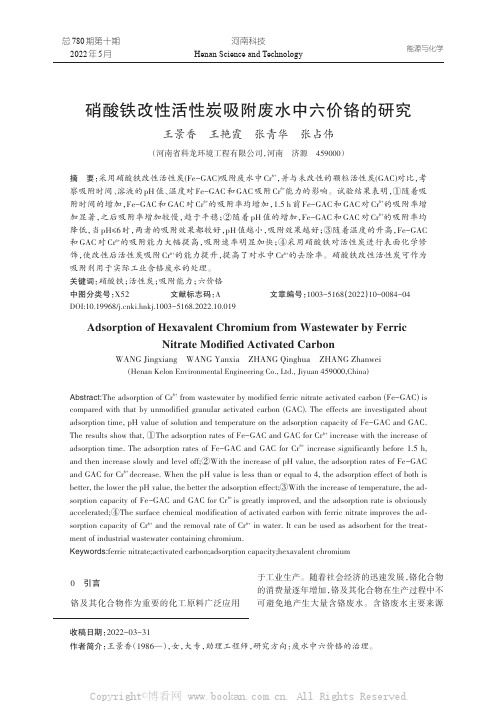
河南科技Henan Science and Technology 能源与化学总780期第十期2022年5月硝酸铁改性活性炭吸附废水中六价铬的研究王景香王艳霞张青华张占伟(河南省科龙环境工程有限公司,河南济源459000)摘要:采用硝酸铁改性活性炭(Fe-GAC)吸附废水中Cr6+,并与未改性的颗粒活性炭(GAC)对比,考察吸附时间、溶液的pH值、温度对Fe-GAC和GAC吸附Cr6+能力的影响。
试验结果表明,①随着吸附时间的增加,Fe-GAC和GAC对Cr6+的吸附率均增加,1.5h前Fe-GAC和GAC对Cr6+的吸附率增加显著,之后吸附率增加较慢,趋于平稳;②随着pH值的增加,Fe-GAC和GAC对Cr6+的吸附率均降低,当pH≤6时,两者的吸附效果都较好,pH值越小,吸附效果越好;③随着温度的升高,Fe-GAC 和GAC对Cr6+的吸附能力大幅提高,吸附速率明显加快;④采用硝酸铁对活性炭进行表面化学修饰,使改性后活性炭吸附Cr6+的能力提升,提高了对水中Cr6+的去除率。
硝酸铁改性活性炭可作为吸附剂用于实际工业含铬废水的处理。
关键词:硝酸铁;活性炭;吸附能力;六价铬中图分类号:X52文献标志码:A文章编号:1003-5168(2022)10-0084-04 DOI:10.19968/ki.hnkj.1003-5168.2022.10.019Adsorption of Hexavalent Chromium from Wastewater by FerricNitrate Modified Activated CarbonWANG Jingxiang WANG Yanxia ZHANG Qinghua ZHANG Zhanwei(Henan Kelon Environmental Engineering Co.,Ltd.,Jiyuan459000,China)Abstract:The adsorption of Cr6+from wastewater by modified ferric nitrate activated carbon(Fe-GAC)is compared with that by unmodified granular activated carbon(GAC).The effects are investigated about adsorption time,pH value of solution and temperature on the adsorption capacity of Fe-GAC and GAC. The results show that,①The adsorption rates of Fe-GAC and GAC for Cr6+increase with the increase of adsorption time.The adsorption rates of Fe-GAC and GAC for Cr6+increase significantly before1.5h, and then increase slowly and level off;②With the increase of pH value,the adsorption rates of Fe-GAC and GAC for Cr6+decrease.When the pH value is less than or equal to4,the adsorption effect of both is better,the lower the pH value,the better the adsorption effect;③With the increase of temperature,the ad⁃sorption capacity of Fe-GAC and GAC for Cr6+is greatly improved,and the adsorption rate is obviously accelerated;④The surface chemical modification of activated carbon with ferric nitrate improves the ad⁃sorption capacity of Cr6+and the removal rate of Cr6+in water.It can be used as adsorbent for the treat⁃ment of industrial wastewater containing chromium.Keywords:ferric nitrate;activated carbon;adsorption capacity;hexavalent chromium0引言铬及其化合物作为重要的化工原料广泛应用于工业生产。
改性活性炭吸附水中六价铬离子的研究
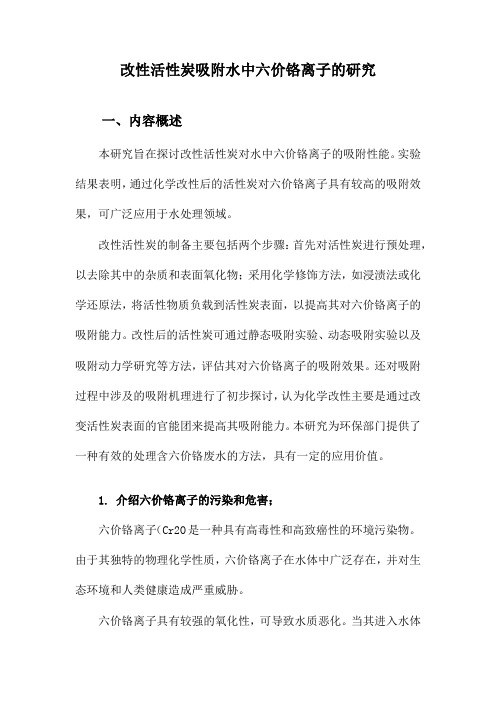
改性活性炭吸附水中六价铬离子的研究一、内容概述本研究旨在探讨改性活性炭对水中六价铬离子的吸附性能。
实验结果表明,通过化学改性后的活性炭对六价铬离子具有较高的吸附效果,可广泛应用于水处理领域。
改性活性炭的制备主要包括两个步骤:首先对活性炭进行预处理,以去除其中的杂质和表面氧化物;采用化学修饰方法,如浸渍法或化学还原法,将活性物质负载到活性炭表面,以提高其对六价铬离子的吸附能力。
改性后的活性炭可通过静态吸附实验、动态吸附实验以及吸附动力学研究等方法,评估其对六价铬离子的吸附效果。
还对吸附过程中涉及的吸附机理进行了初步探讨,认为化学改性主要是通过改变活性炭表面的官能团来提高其吸附能力。
本研究为环保部门提供了一种有效的处理含六价铬废水的方法,具有一定的应用价值。
1. 介绍六价铬离子的污染和危害;六价铬离子(Cr2O是一种具有高毒性和高致癌性的环境污染物。
由于其独特的物理化学性质,六价铬离子在水体中广泛存在,并对生态环境和人类健康造成严重威胁。
六价铬离子具有较强的氧化性,可导致水质恶化。
当其进入水体后,会与水质中的有机物、无机物等发生氧化还原反应,使水质变得油腻、发臭、发黑,破坏水生生物的生存环境,影响水资源的可用性。
长期接触或饮用含有高浓度六价铬离子的水会对人体产生潜在的致癌风险。
六价铬离子可导致实验动物患上皮肤癌、肺癌、肝癌等多种癌症。
对于人类而言,六价铬离子还可能引起慢性中毒,症状表现为皮肤溃疡、呼吸道刺激、消化系统疾病等。
消除六价铬离子污染,保障水质安全具有重要现实意义。
2. 提出改性活性炭吸附水中六价铬离子的重要性;在现代工业生产过程中,水资源的污染已经成为一个全球性的环境问题。
尤其是重金属离子,如六价铬离子,由于具有高毒性、难降解和广泛存在等特点,对生态环境和人类健康构成了严重威胁。
开发高效、环保的六价铬离子去除技术显得尤为重要。
活性炭作为一种具有极高比表面积和优良孔隙结构的碳材料,在水处理领域具有广泛的应用基础。
- 1、下载文档前请自行甄别文档内容的完整性,平台不提供额外的编辑、内容补充、找答案等附加服务。
- 2、"仅部分预览"的文档,不可在线预览部分如存在完整性等问题,可反馈申请退款(可完整预览的文档不适用该条件!)。
- 3、如文档侵犯您的权益,请联系客服反馈,我们会尽快为您处理(人工客服工作时间:9:00-18:30)。
矿产资源开发利用方案编写内容要求及审查大纲
矿产资源开发利用方案编写内容要求及《矿产资源开发利用方案》审查大纲一、概述
㈠矿区位置、隶属关系和企业性质。
如为改扩建矿山, 应说明矿山现状、
特点及存在的主要问题。
㈡编制依据
(1简述项目前期工作进展情况及与有关方面对项目的意向性协议情况。
(2 列出开发利用方案编制所依据的主要基础性资料的名称。
如经储量管理部门认定的矿区地质勘探报告、选矿试验报告、加工利用试验报告、工程地质初评资料、矿区水文资料和供水资料等。
对改、扩建矿山应有生产实际资料, 如矿山总平面现状图、矿床开拓系统图、采场现状图和主要采选设备清单等。
二、矿产品需求现状和预测
㈠该矿产在国内需求情况和市场供应情况
1、矿产品现状及加工利用趋向。
2、国内近、远期的需求量及主要销向预测。
㈡产品价格分析
1、国内矿产品价格现状。
2、矿产品价格稳定性及变化趋势。
三、矿产资源概况
㈠矿区总体概况
1、矿区总体规划情况。
2、矿区矿产资源概况。
3、该设计与矿区总体开发的关系。
㈡该设计项目的资源概况
1、矿床地质及构造特征。
2、矿床开采技术条件及水文地质条件。
